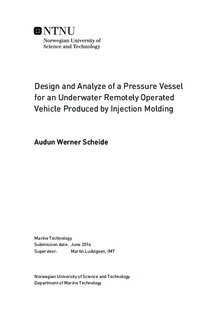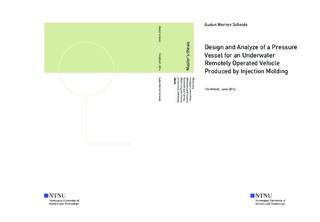| dc.description.abstract | BluEye Robotics aims to create a mass produced remotely operated vehicle for the consumer marked, that can be used in all parts of the world. For the next generation prototype they want the possibility of mass producing the entire hull, and are looking into a more cost effective production method than machining. Injection molding is a commercially well-known method for plastic mass production, and the main objective of this thesis is to investigate the possibilities of producing the P1 prototype by injection molding, and operate down to 100 m depth.
The vehicle is produced in two parts, where the front part is pressure resistant and the back part is used for thruster assembly. Designing for the global environment required that the analyses included all relevant material properties that varied with temperature. This required a thorough material selection process and evaluation of the structural capacity of the pressure vessel. Material selection was based on a number of criteria, that was weighted on the importance of the various properties, and with respect to BluEyes interests. Many different polymers were available, with a large range of possible reinforcement combinations, and the selection was done by evaluating the price, water absorption, mechanical properties, density and how well the polymer could be manufactured by injection molding. Polyamide 66 (PA) with 30% glass fibers reinforcement was chosen for the pressure vessel design, mainly due to its combination of mechanical properties, price and suitability for injection molding.
Injection molding is a process where the polymer is heated, before injected into a mold cavity and kept in place over time. The part then cools off, before being ejected from the mold. Designing the pressure vessel for injection molding required care in the dimensioning, as there were several design limitations and requirements that had to be followed for the hull to behave as designed. As the heated polymer are injected into the mold, it requires a smooth flow that fills all the corners and cavitation of the mold. If the ROV exceeded the design limitations, it could result in improper filling of the mold and a vehicle with flaws and reduced strength. In addition, sink holes, warping and deformation of the geometry could occur, if the stiffeners of the vessel were designed with improper dimensions related to the hull thickness. A maximum nominal thickness of 2.92 mm was recommended for the PA 66 30% GF plastic. Restrictions were sat for the filet radius, height and width of the stiffeners and minimum distance between adjacent stiffeners. This put a severe limitation on the design of stiffeners for the pressure vessel. Therefore, the model was designed with maximized height and width of the stiffeners, while minimizing the distance between them. After the cooling process the part is pulled from its mold, and all stiffeners should be aligned with the pulling direction to avoid being destroyed in the process. To avoid additional tools for the manufacturing process it was not possible to stiffen all parts of the vessel in two directions.
Both static and buckling analyses were performed to calculate the structural capacity of the vessel. In all analyses the connection between the front and back compartments was assumed to be perfect, to give an indication of the structural performance of the pressure vessel itself. The static analyses indicated that there were large stress concentrations present, and that displacements were too large for the design to operate down to 100 m depths. A hull with a dry PA66 30% GF was able to operate down to 37 m before the material yielded, while in fully conditioned state the hull was only able to resist the pressure down to 24.5 m. PA66 30% GF was four times as strong as the ABS plastic used in the P1 prototype, but the pressure vessel could not be modified for injection molding and stiffened enough to meet the operational requirements. As the maximum nominal thickness put restrictions on the stiffeners, there were no possibilities for adding additional stiffness to the design. The geometry had large stress concentrations, especially in the back compartment, due to the filet radius limitation of 0.25 times the nominal thickness. The front compartment had a large global radius and the stresses were below the yield stress, both in dry and fully conditioned state. This indicated that a larger global radius on the back compartment would distribute the stresses better, and decrease the stress concentrations. Even if the back compartment was designed with the same shape as the front compartment there would still be significant displacements, and buckling analyses indicated that buckling would become a problem between 37 m and 53 m depth, depending on the amount of absorbed water. Additional, internal stiffening devices would reduce the displacements, but the lack of stiffness in the walls orthogonal to the pulling direction would result in buckling before reaching the design depth. It is necessary to invest in additional equipment to manufacture stiffeners in the walls where the buckling occurred, if the present design shall meet the requirements. This will be an benefit versus investment evaluation BluEye have to do, before designing the next prototype. | |

